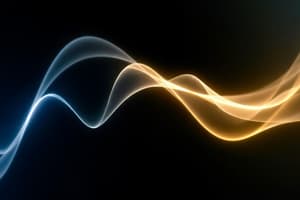Podcast
Questions and Answers
How tall does a mirror need to be for a person who is 6 ft tall to see their full reflection?
How tall does a mirror need to be for a person who is 6 ft tall to see their full reflection?
- 5 ft
- 3 ft (correct)
- 2 ft
- 4 ft
What does the brain do when visual information is received from a mirror?
What does the brain do when visual information is received from a mirror?
- Enhances the image clarity
- Ignores the reflection
- Stores the information permanently
- Falsely maps the situation (correct)
If someone stands 6 meters away from a flat mirror, how far away is their virtual image?
If someone stands 6 meters away from a flat mirror, how far away is their virtual image?
- 3 meters
- 6 meters (correct)
- 12 meters
- 9 meters
What determines how much of yourself you can see in a mirror?
What determines how much of yourself you can see in a mirror?
What is a virtual image formed in a mirror perceived as?
What is a virtual image formed in a mirror perceived as?
What does 'P.D.' stand for in the context of light interference?
What does 'P.D.' stand for in the context of light interference?
What causes the colors observed in thin films, such as soap bubbles?
What causes the colors observed in thin films, such as soap bubbles?
In the equation $P.D. = \lambda (#)$, what does $\lambda$ represent?
In the equation $P.D. = \lambda (#)$, what does $\lambda$ represent?
Which statement accurately describes monochromatic light?
Which statement accurately describes monochromatic light?
What occurs at dark spots in an interference pattern?
What occurs at dark spots in an interference pattern?
What does the distance 'd' represent in the interference equation?
What does the distance 'd' represent in the interference equation?
How is the path difference defined in light interference?
How is the path difference defined in light interference?
What phenomenon leads to the creation of light spots in interference patterns?
What phenomenon leads to the creation of light spots in interference patterns?
What happens to wave diffraction as the opening becomes narrower compared to the wavelength?
What happens to wave diffraction as the opening becomes narrower compared to the wavelength?
What does Young's Double-Slit experiment primarily demonstrate?
What does Young's Double-Slit experiment primarily demonstrate?
What type of fringe does constructive interference produce in the double-slit experiment?
What type of fringe does constructive interference produce in the double-slit experiment?
What occurs to the color of a red pigment when light is reflected?
What occurs to the color of a red pigment when light is reflected?
What characteristic of waves is demonstrated through the superposition principle?
What characteristic of waves is demonstrated through the superposition principle?
Which combination of colors is considered the subtractive primaries?
Which combination of colors is considered the subtractive primaries?
Which type of light is used in Young's Double-Slit experiment?
Which type of light is used in Young's Double-Slit experiment?
Why does the sky appear blue during the day?
Why does the sky appear blue during the day?
What results from diffraction grating when light passes through it?
What results from diffraction grating when light passes through it?
What causes the ocean to appear greenish-blue?
What causes the ocean to appear greenish-blue?
What is the Law of Reflection?
What is the Law of Reflection?
What effect does increasing mass have on an object's wave-particle nature?
What effect does increasing mass have on an object's wave-particle nature?
What happens to the light during a sunset?
What happens to the light during a sunset?
What is the relationship between wavelength and diffraction effectiveness?
What is the relationship between wavelength and diffraction effectiveness?
How does a flat mirror specifically reflect light?
How does a flat mirror specifically reflect light?
What defines the normal line in relation to a mirrored surface?
What defines the normal line in relation to a mirrored surface?
What color will a white square of paper appear when illuminated with solely blue light?
What color will a white square of paper appear when illuminated with solely blue light?
What happens to the color of an object when illuminated by light that does not match its natural frequency?
What happens to the color of an object when illuminated by light that does not match its natural frequency?
Which combination of colors produces yellow in additive mixing?
Which combination of colors produces yellow in additive mixing?
What is the term for when materials absorb light of certain frequencies and reflect others?
What is the term for when materials absorb light of certain frequencies and reflect others?
What are the three additive primary colors?
What are the three additive primary colors?
Which combination of colors creates white light in additive mixing?
Which combination of colors creates white light in additive mixing?
What color will a red pigment reflect and absorb?
What color will a red pigment reflect and absorb?
What is the reason that our eyes can differentiate a wider range of colors?
What is the reason that our eyes can differentiate a wider range of colors?
Cyan and red are classified as what type of colors?
Cyan and red are classified as what type of colors?
When mixing pigments, what is the outcome when red, green, and blue pigments are combined?
When mixing pigments, what is the outcome when red, green, and blue pigments are combined?
What is the distance from the mirror to the center of curvature in relation to the focal point?
What is the distance from the mirror to the center of curvature in relation to the focal point?
How are distances considered on the light side of the mirror?
How are distances considered on the light side of the mirror?
What does a negative magnification value indicate about the image?
What does a negative magnification value indicate about the image?
In a concave mirror, where will the image be when the object is closer than the focal point?
In a concave mirror, where will the image be when the object is closer than the focal point?
Which of the following formulas is used to relate object distance, image distance, and focal distance in a mirror?
Which of the following formulas is used to relate object distance, image distance, and focal distance in a mirror?
What shape does a concave mirror resemble when conceptualizing it in a full circle?
What shape does a concave mirror resemble when conceptualizing it in a full circle?
What occurs to light waves when they enter a medium with a different index of refraction?
What occurs to light waves when they enter a medium with a different index of refraction?
Convex mirrors are known for which key characteristic?
Convex mirrors are known for which key characteristic?
What does the index of refraction measure?
What does the index of refraction measure?
Which of the following statements is true regarding the location of the image when the object is further from the mirror than the focal point?
Which of the following statements is true regarding the location of the image when the object is further from the mirror than the focal point?
Flashcards
Diffraction
Diffraction
The spreading of a wave as it passes through a narrow opening or around a sharp edge.
Diffraction and Size
Diffraction and Size
The amount of diffraction depends on the relative sizes of the wavelength and the opening. Narrower openings produce more diffraction.
Wavelength and Diffraction
Wavelength and Diffraction
Long wavelengths diffract more, leading to fuzzier shadows.
Superposition Principle
Superposition Principle
Signup and view all the flashcards
Young's Double-Slit Experiment
Young's Double-Slit Experiment
Signup and view all the flashcards
Constructive Interference
Constructive Interference
Signup and view all the flashcards
Destructive Interference
Destructive Interference
Signup and view all the flashcards
Wave-Particle Duality
Wave-Particle Duality
Signup and view all the flashcards
Reflection
Reflection
Signup and view all the flashcards
Angle of Incidence
Angle of Incidence
Signup and view all the flashcards
Angle of Reflection
Angle of Reflection
Signup and view all the flashcards
Normal Line
Normal Line
Signup and view all the flashcards
How Flat Mirrors Work
How Flat Mirrors Work
Signup and view all the flashcards
What is 'd' in the equation (d)(y)/x?
What is 'd' in the equation (d)(y)/x?
Signup and view all the flashcards
What does 'x' represent in the equation (d)(y)/x?
What does 'x' represent in the equation (d)(y)/x?
Signup and view all the flashcards
What does 'y' represent in the equation (d)(y)/x ?
What does 'y' represent in the equation (d)(y)/x ?
Signup and view all the flashcards
What is Path Difference (P.D.)?
What is Path Difference (P.D.)?
Signup and view all the flashcards
What is 'λ (Lambda)' in the equation P.D. = (λ)(#)?
What is 'λ (Lambda)' in the equation P.D. = (λ)(#)?
Signup and view all the flashcards
What does '#' represent in the equation P.D. = (λ)(#)?
What does '#' represent in the equation P.D. = (λ)(#)?
Signup and view all the flashcards
What is laser light?
What is laser light?
Signup and view all the flashcards
What is incoherent light?
What is incoherent light?
Signup and view all the flashcards
Color perception
Color perception
Signup and view all the flashcards
Black and white
Black and white
Signup and view all the flashcards
RGB color vision
RGB color vision
Signup and view all the flashcards
Sunlight's color
Sunlight's color
Signup and view all the flashcards
Additive color mixing
Additive color mixing
Signup and view all the flashcards
Subtractive color mixing
Subtractive color mixing
Signup and view all the flashcards
Complementary colors
Complementary colors
Signup and view all the flashcards
Transparent objects
Transparent objects
Signup and view all the flashcards
Dark colors and heat
Dark colors and heat
Signup and view all the flashcards
Color under blue light
Color under blue light
Signup and view all the flashcards
Mirror Image Distance
Mirror Image Distance
Signup and view all the flashcards
Virtual Image Formation
Virtual Image Formation
Signup and view all the flashcards
Mirror Size & Reflection
Mirror Size & Reflection
Signup and view all the flashcards
Angle of Incidence & Reflection
Angle of Incidence & Reflection
Signup and view all the flashcards
Curved Mirrors & Distortion
Curved Mirrors & Distortion
Signup and view all the flashcards
Focal Point (Concave Mirror)
Focal Point (Concave Mirror)
Signup and view all the flashcards
Center of Curvature (Concave Mirror)
Center of Curvature (Concave Mirror)
Signup and view all the flashcards
Focal Length (Concave Mirror)
Focal Length (Concave Mirror)
Signup and view all the flashcards
Object Distance (Concave Mirror)
Object Distance (Concave Mirror)
Signup and view all the flashcards
Image Distance (Concave Mirror)
Image Distance (Concave Mirror)
Signup and view all the flashcards
Concave Mirror
Concave Mirror
Signup and view all the flashcards
Magnification (Concave Mirror)
Magnification (Concave Mirror)
Signup and view all the flashcards
Convex Mirror
Convex Mirror
Signup and view all the flashcards
Index of Refraction
Index of Refraction
Signup and view all the flashcards
Study Notes
Light
- Light is the only thing visible to the human eye
- Light is both a particle and a wave
- Light often travels in straight lines, behaving like a particle
- Light can knock electrons out of their orbits
- All objects either emit or reflect light
Photon
- A photon is a massless bundle of electromagnetic energy, a particle of light
- Photons behave like particles, not waves
Speed of Light
- 300 million m/s (3 x 10⁸)
- A universal constant
- The distance light travels in a year is a light-year
Electromagnetic Spectrum
- Ordered from longest wavelength to shortest wavelength
- Ordered from lowest frequency to highest frequency
- Ordered from lowest energy to highest energy per photon
Radio waves
- Used for communication
- Encode information
- Travel fast
Microwaves
- Used for communication, cooking food
- Resonate with the electrons of water molecules, heating
Infrared
- Detected by infrared goggles
- Used to see warm objects
Visible Light
- The light the human eye can see
Ultraviolet (UV) light
- High energy
Studying That Suits You
Use AI to generate personalized quizzes and flashcards to suit your learning preferences.




